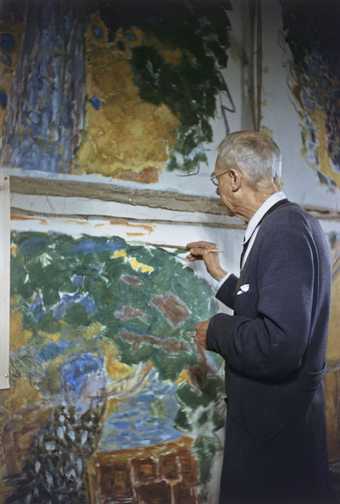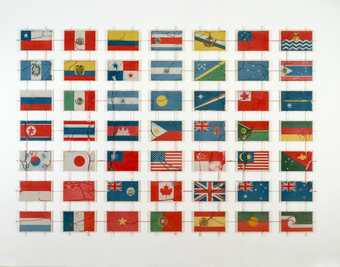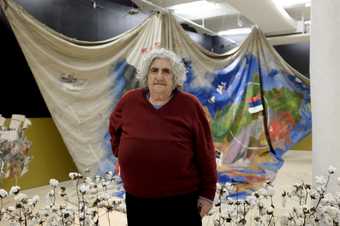
Anna Boghiguian in her exhibition The Loom of History at the New Museum, New York, 2018
Courtesy New Museum, photo: Chloe Foussianes
Anna Boghiguian (b1946) interprets the world via the connections running through it: the flow of goods, ideas, capital and people. She reads and travels greedily, channelling her experiences into drawing and text before launching them off the page to create complex and evocative installations. Figure drawings and crowd scenes on paper – often stiffened with wax – perform like free-standing shadow puppets. Translucent pictures and diagrams appear pasted to windowpanes like stained glass. Vast sails strung from the roof become her canvases, gallery walls the pages of a collaged book. Text, line drawings, rich inks, scraps of photographs and sculptures intermingle in a chorus of related stories.
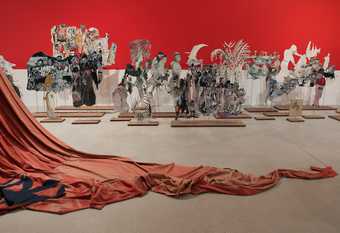
Anna Boghiguian, Promenade dans l'inconscient (A Walk in the Unconscious) 2016, Tate St Ives, 2019
Photo © Tate / Andrew Dunkley
Born in Cairo to an Armenian family, Boghiguian first studied political science at the city’s American University before moving to Canada to study art and music in the early 1970s. Her work remains politically engaged and firmly international in viewpoint. A nomadic artist long resistant to exhibiting, it was only after her bags were stolen – and her work with them – on a train to Egypt that she was persuaded it might be better for the art to be lost with an audience than without.

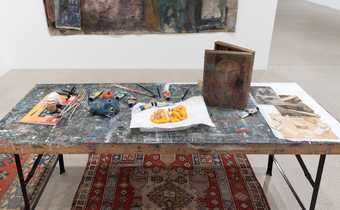
Anna Boghiguian, The Studio, a replica of Boghiguian’s studio in Cairo, Tate St Ives, 2019
Photo © Tate / Andrew Dunkley
Boghiguian’s bibliophilia extends beyond her passion as a reader to the format of her work: the portability of her artworks in the form of books suited her peripatetic lifestyle. Her work has leapt to a new, enveloping scale with a series of major commissions this last decade. The first of these, Unfinished Symphony 2011–12 (shown at the Sharjah Biennial and documenta XIII in Kassel) included suites of drawings in frames, which fitted over existing windows so that the light glowed through. Thus arranged, Boghiguian’s drawings suggest connections between the crises and conflicts in our own time and the events dating back, beyond the Second and First World Wars, to the empires of earlier centuries, like unholy stations of the cross.
For each of these larger commissions, Boghiguian has spiralled her vision of an interconnected world inwards to focus on the specific location of the exhibition. The Salt Traders 2015 was created for the Istanbul Biennial – mounds of salt and fragments of boats, over which were strung vast painted sails. The work looked back to the Byzantine Empire and Istanbul’s earlier incarnation as Constantinople – a city sitting between two seas and straddling two continents – and the wealth that came from controlling trade routes and the sale of salt.
The Salt Traders will be setting sail for Boghiguian’s exhibition at Tate St Ives, placing this coastal gallery within the ancient network of exchange and control referenced by the work. Her new project for St Ives draws on specific local heritage – harking back to the days when Cornwall’s wealth came from tin, copper, clay and fish – and looks at the forces that turned it from an industrial county into one sustained by tourism.
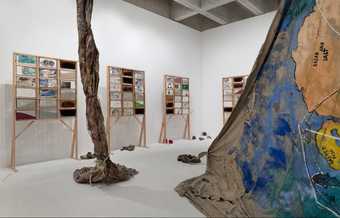
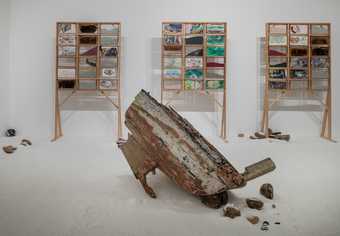
Anna Boghiguian, The Salt Traders 2015, Tate St Ives, 2019
Photo © Tate / Andrew Dunkley
For each of these larger commissions, Boghiguian has spiralled her vision of an interconnected world inwards to focus on the specific location of the exhibition. The Salt Traders 2015 was created for the Istanbul Biennial – mounds of salt and fragments of boats, over which were strung vast painted sails. The work looked back to the Byzantine Empire and Istanbul’s earlier incarnation as Constantinople – a city sitting between two seas and straddling two continents – and the wealth that came from controlling trade routes and the sale of salt.
The Salt Traders has now set sail for Boghiguian’s exhibition at Tate St Ives, placing this coastal gallery within the ancient network of exchange and control referenced by the work. Her new project for St Ives draws on specific local heritage – harking back to the days when Cornwall’s wealth came from tin, copper, clay and fish – and looks at the forces that turned it from an industrial county into one sustained by tourism.
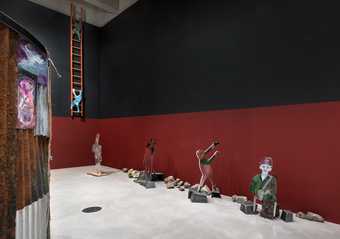
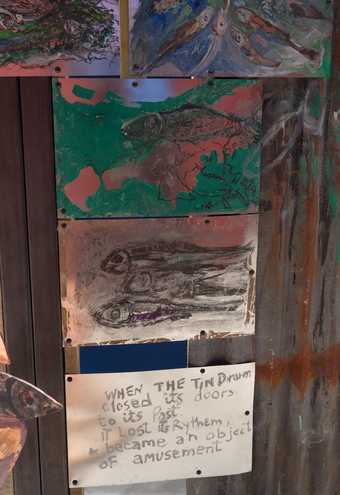
Anna Boghiguian, A Tin Drum that has Forgotten its own Rhythm 2019, Tate St Ives, 2019
Photo © Tate / Andrew Dunkley
Boghiguian’s works can be seen as a continuum, reflecting how her research has led her from one area of interest to the next, as well as showing her ongoing experiments with form and technique. Her most recent commission – A Meteor Fell from the Sky 2018 – was created for the National Museum Cardiff in Wales when Boghiguian was nominated for the eighth Artes Mundi award. It traces the history of steel, from the descent of iron-rich meteorites to the activities of the multinational Tata Group. Against walls painted intense shades of magenta, cobalt, hot yellow and indigo, processions of figures cut from steel as well as wax-thickened paper lead their way through a centuries-long procession in which the human mind becomes integrated into the great steel machine powering and arming the world.
South Wales was one of the cradles of the industrial revolution. Steel is still a major industry, and the Tata Group now owns the works at Port Talbot. A Meteor Fell from the Sky weaves that local history into stories of global exploitation and conflict, marking the role that steel production played in the formation of Imperial Germany in 1871, as well as its impact on British power from the 1860s onwards.
Metal – and its role in industry, arms and international trade – shines, too, in the new work for St Ives. This material has entered Boghiguian’s formal vocabulary as well, appearing in industrial structures and giving stiff form to silhouetted figures. In drawings and text, tin and pilchards, the artist will mine England’s westernmost tip to uncover its deep history and long-standing global connection.
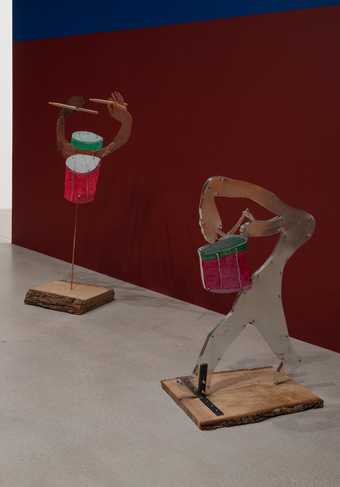
Anna Boghiguian, A Tin Drum that has Forgotten its own Rhythm 2019, Tate St Ives, 2019
Photo © Tate / Andrew Dunkley
Anna Boghiguian, Tate St Ives, 8 February – 6 May. Curated by Carolyn Christov-Bakargiev, Director, and Marianna Vecellio, Curator, Castello di Rivoli Museo d’Arte Contemporanea, Rivoli-Turin with Anne Barlow, Director, Tate St Ives. Artes Mundi 8 continues at National Museum Cardiff until 24 February.
Hettie Judah is a writer and art critic based in London.

